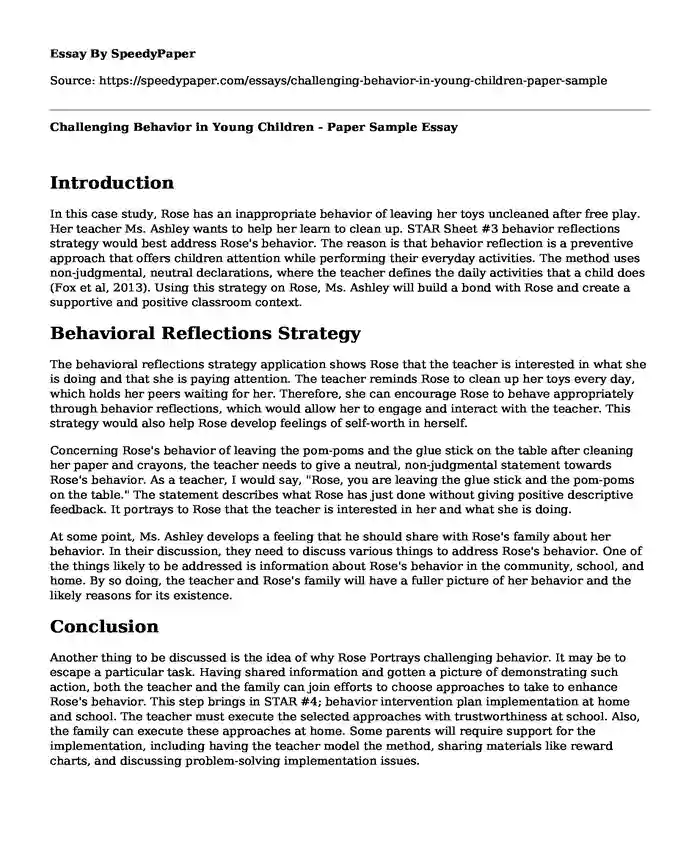
| Type of paper: | Essay |
| Categories: | Child development |
| Pages: | 2 |
| Wordcount: | 483 words |
Introduction
In this case study, Rose has an inappropriate behavior of leaving her toys uncleaned after free play. Her teacher Ms. Ashley wants to help her learn to clean up. STAR Sheet #3 behavior reflections strategy would best address Rose's behavior. The reason is that behavior reflection is a preventive approach that offers children attention while performing their everyday activities. The method uses non-judgmental, neutral declarations, where the teacher defines the daily activities that a child does (Fox et al, 2013). Using this strategy on Rose, Ms. Ashley will build a bond with Rose and create a supportive and positive classroom context.
Behavioral Reflections Strategy
The behavioral reflections strategy application shows Rose that the teacher is interested in what she is doing and that she is paying attention. The teacher reminds Rose to clean up her toys every day, which holds her peers waiting for her. Therefore, she can encourage Rose to behave appropriately through behavior reflections, which would allow her to engage and interact with the teacher. This strategy would also help Rose develop feelings of self-worth in herself.
Concerning Rose's behavior of leaving the pom-poms and the glue stick on the table after cleaning her paper and crayons, the teacher needs to give a neutral, non-judgmental statement towards Rose's behavior. As a teacher, I would say, "Rose, you are leaving the glue stick and the pom-poms on the table." The statement describes what Rose has just done without giving positive descriptive feedback. It portrays to Rose that the teacher is interested in her and what she is doing.
At some point, Ms. Ashley develops a feeling that he should share with Rose's family about her behavior. In their discussion, they need to discuss various things to address Rose's behavior. One of the things likely to be addressed is information about Rose's behavior in the community, school, and home. By so doing, the teacher and Rose's family will have a fuller picture of her behavior and the likely reasons for its existence.
Conclusion
Another thing to be discussed is the idea of why Rose Portrays challenging behavior. It may be to escape a particular task. Having shared information and gotten a picture of demonstrating such action, both the teacher and the family can join efforts to choose approaches to take to enhance Rose's behavior. This step brings in STAR #4; behavior intervention plan implementation at home and school. The teacher must execute the selected approaches with trustworthiness at school. Also, the family can execute these approaches at home. Some parents will require support for the implementation, including having the teacher model the method, sharing materials like reward charts, and discussing problem-solving implementation issues.
References
Fox, L., Clarke, S., & Dunlap, G.(2013).Helping families address challenging behavior: Using positive behavior support in early intervention.[Monograph].Young Exceptional Children, 15, 59–75.
Kaiser (2017). Challenging Behavior in Young Children. 4th Edition. Prentice Hall. ISBN: 978-0-13—380266-5
Cite this page
Challenging Behavior in Young Children - Paper Sample. (2024, Jan 11). Retrieved from https://speedypaper.net/essays/challenging-behavior-in-young-children-paper-sample
Request Removal
If you are the original author of this essay and no longer wish to have it published on the SpeedyPaper website, please click below to request its removal:
- Free Essay Example on Permissive Parenting
- Essay Example: The Benefits of the Stay-at-Home Dads
- Essay Sample on Learning in the Workplace
- Conducting a Needs Assessment. Paper Example
- Essay Example: Children's Skin Disorders
- Paper Example. Comparison and Contrast of ODD and DMDD Basis
- Paper on Unlocking Potential: The Impact of Competitive Athletics on Personal Development and Academic Success
Popular categories




